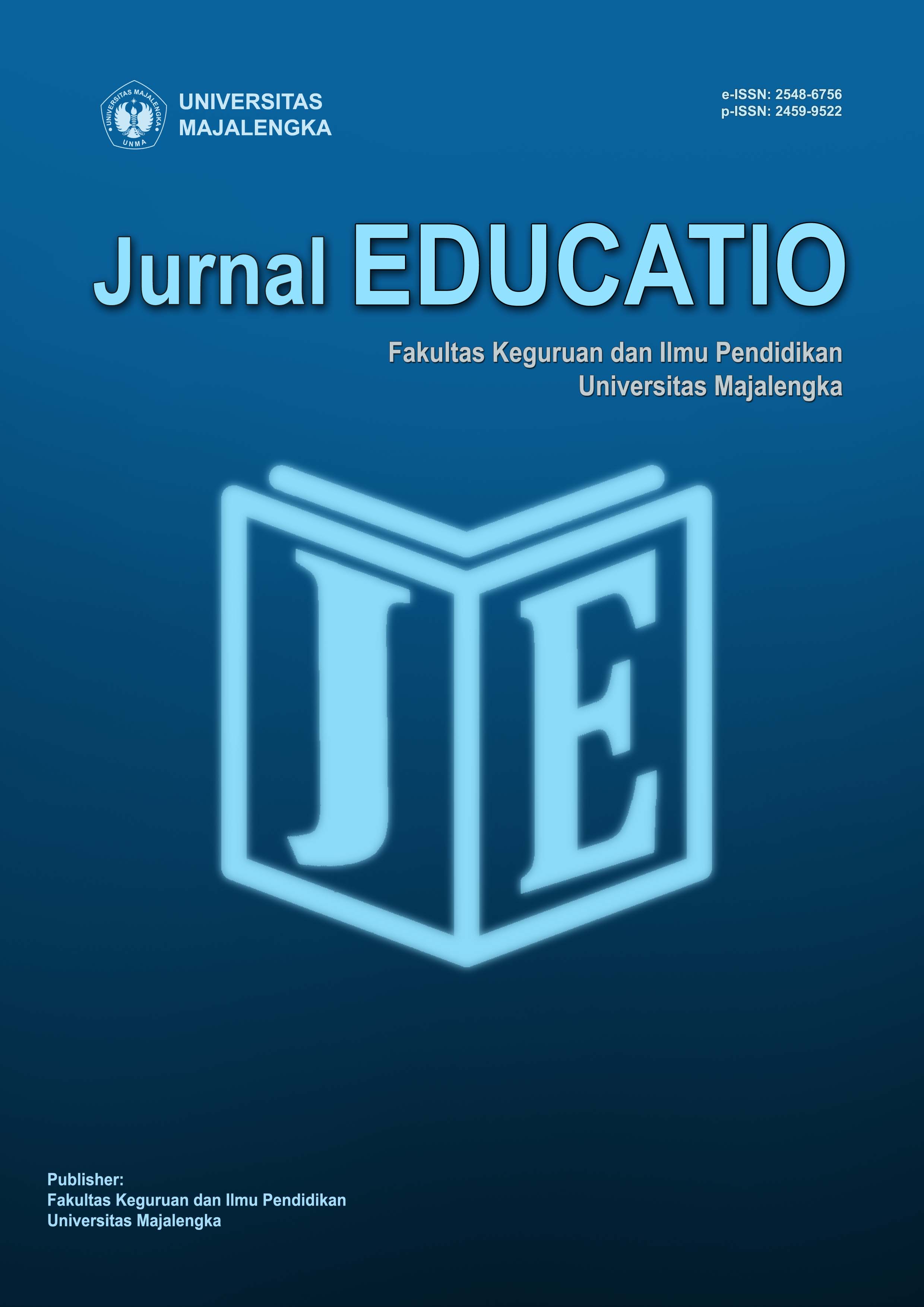Kesulitan Proses Matematisasi Siswa Dalam Menyelesaikan Soal Cerita Ditinjau Dari Adversity Quotient
DOI:
https://doi.org/10.31949/educatio.v9i3.5155Abstract
Penelitian ini bertujuan untuk mendeskripsikan kesulitan siswa dalam proses matematisasi soal cerita ditinjau dari Adversity Quotient (AQ). Jenis penelitian yang digunakan adalah kualitatif. Subjek penelitian adalah 28 siswa kelas XI–AK 1 Di SMK Nurul Huda Baros. Instrumen yang digunakan adalah angket AQ, tes diagnostik, dan pedoman wawancara. Hasil penelitian menunjukkan bahwa kesulitan siswa dalam proses matematisasi dengan adversity quotient dikelompokkan menjadi 3, yaitu kelompok pertama siswa belum mampu secara maksimal menyelesaikan proses matematisasi tahap horizontal dan vertikal, kelompok ini berada di tipe quitters. Kelompok kedua siswa belum mampu secara maksimal menyelesaikan proses matematisasi tahap vertikal, kelompok ini berada di tipe campers. Sedangkan kelompok ketiga siswa mampu menyelesaikan proses matematisasi tahap horizontal dan vertikal, kelompok ini berada di tipe climbers.
Keywords:
kesulitan, matematisasi, adversity quotientDownloads
References
Afri, L. D. (2018). Hubungan Adversity Quotient dengan Kemampuan Pemecahan Masalah Siswa SMP pada Pembelajaran Matematika. AXIOM: Jurnal Pendidikan Dan Matematika, 7(2).
Aisyah, A. S., Riyadi, R., & Subanti, S. (2021). Description Of The Difficulty Of Students’mathematics Problem Solving Assessed From Adversity Quotient (AQ). AKSIOMA: Jurnal Program Studi Pendidikan Matematika, 10(2), 1161–1170.
Akhter, N., & Akhter, N. (2018). Learning in Mathematics: Difficulties and Perceptions of Students. Journal of Educational Research (1027-9776), 21(1).
Bachri, B. S. (2010). Meyakinkan Validitas Data Melalui Triangulasi pada Penelitian Kualitatif. Jurnal Teknologi Pendidikan, 10(1), 46–62.
Fauziyah, I. N. L., Usodo, B., & Ekana Ch, H. (2013). Proses berpikir kreatif siswa kelas X dalam memecahkan masalah geometri berdasarkan tahapan Wallas ditinjau dari Adversity Quotient (AQ) Siswa. Jurnal Pendidikan Matematika SoLuSi (Tersohor Luas dan Berisi), 1(1).
Hidayah, S. R., Trapsilasiwi, D., & Setiawani, S. (2016). Proses Berpikir Kritis Siswa Kelas VII F MTS. Al-Qodiri 1 Jember dalam Pemecahan Masalah Matematika Pokok Bahasan Segitiga dan Segi Empat Ditinjau dari Adversity Quotient. Jurnal Edukasi, 3(3), 21–26.
Hidayat, W., & Sari, V. T. A. (2019). Kemampuan Berpikir Kritis Matematis dan Adversity Quotient Siswa SMP. Jurnal Elemen, 5(2), 242–252.
Kahar, M. S., & Layn, M. R. (2017). Analisis Kesalahan Siswa dalam Menyelesaikan Soal Cerita Matematika. Jurnal Math Educator Nusantara: Wahana Publikasi Karya Tulis Ilmiah Di Bidang Pendidikan Matematika, 3(2), 95–102.
Kemdikbud. (2019). Arah Baru dalam Pengembangan Pendidikan.
Manibuy, R. (2014). Analisis kesalahan siswa dalam menyelesaikan soal persamaan kuadrat berdasarkan taksonomi solo pada kelas X SMA negeri 1 plus di Kabupaten Nabire–Papua (Doctoral dissertation, UNS (Sebelas Maret University)).
Mena, A. B. (2016). Literasi Matematis Siswa SMP dalam Menyelesaikan Masalah Kontekstual Ditinjau dari Adversity Quotient (AQ). Kreano, Jurnal Matematika Kreatif-Inovatif, 7(2), 187–198.
Mutmainna, D., Mania, S., & Sriyanti, A. (2018). Pengembangan Instrumen Tes Diagnostik Pilihan Ganda Dua Tingkat Untuk Mengidentifikasi Pemahaman Konsep Matematika. MaPan: Jurnal Matematika dan Pembelajaran, 6(1), 56–69.
Syahara, M. U., & Astutik, E. P. (2021). Analisis Berpikir Kreatif Siswa dalam Menyelesaikan Masalah SPLDV ditinjau dari Kemampuan Matematika. Mosharafa: Jurnal Pendidikan Matematika, 10(2), 201-212.
Tall, D., & Razali, M. R. (1993). Diagnosing students’ difficulties in learning mathematics. International Journal of Mathematical Education in Science and Technology, 24(2), 209-222.
Widyaningrum, A. Z. (2016). Analisis Kesulitan Siswa dalam Mengerjakansoal Cerita Matematika Materi Aritmatika Sosial Ditinjau dari Gaya Belajar Siswa Kelas VII SMP Negeri 5 Metro tahun pelajaran 2015/2016. Jurnal Iqra’: Kajian Ilmu Pendidikan, 1(2), 165–190.
Zainurie. (2007). Pembelajaran Matematika Realistik (RME).
Published
How to Cite
Issue
Section
License
Copyright (c) 2023 Sadriah, Etika Khaerunnisa, Syamsuri

This work is licensed under a Creative Commons Attribution-ShareAlike 4.0 International License.
An author who publishes in the Jurnal Educatio FKIP UNMA agrees to the following terms:
- Author retains the copyright and grants the journal the right of first publication of the work simultaneously licensed under the Creative Commons Attribution-ShareAlike 4.0 License that allows others to share the work with an acknowledgment of the work's authorship and initial publication in this journal
- The author is able to enter into separate, additional contractual arrangements for the non-exclusive distribution of the journal's published version of the work (e.g., post it to an institutional repository or publish it in a book) with the acknowledgment of its initial publication in this journal.
- The author is permitted and encouraged to post his/her work online (e.g., in institutional repositories or on their website) prior to and during the submission process, as it can lead to productive exchanges, as well as earlier and greater citation of the published work













